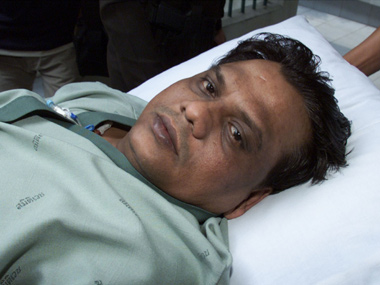The Monday arrest of Rajendra Sadashiv Nikalje, better known as Chhota Rajan, 20 years since Interpol issued a red-corner notice for him, raises more questions than it answers. ‘Why now?’ and ‘Just what information can the Indian authorities hope to extract from him?’ are just two of the questions yet to be answered. The arrest According to reports, including
this one in The Times of India, Interpol was tipped off by Australian authorities about Rajan’s request for a visa extension. Later the Interpol in Canberra alerted Indonesian authorities, who arrested Rajan ‘at the request of Indian authorities’, The Indian Express reports. The operation to nab Rajan — believed to be living in Newcastle, New South Wales — had reportedly been in progress since around a month ago, when Rajan applied for a visa extension. It was during the process of verification that Australian authorities realised that this was a fugitive wanted by the Indian government, according to the Indian Express report. At first, there was some confusion, in the media, as to whether the man arrested was indeed
Rajan or Mohan Kumar , also known as Cyanide Mohan who has been housed in a Karnataka jail since receiving the death sentence in December 2013. It later transpired that Rajan’s passport was in the name of a ‘Mohan Kumar’, a generic enough name, but clearly not generic enough. [caption id=“attachment_2483498” align=“alignleft” width=“380”] Chhota Rajan. Reuters[/caption] The extradition As with the identity of the arrested man, there was a sense of confusion about whether there was even a provision for New Delhi to bring Rajan back to Indian soil to presumably answer for his crimes over the years. And so, while the Indian Ministry of External Affairs website clearly
mentions the signing of an extradition treaty between then external affairs minister SM Krishna and his Indonesian counterpart Dr Marty Natalegawa in 2011, something
this video also shows, the treaty was never ratified by the Indonesian parliament. The
exchange of letters ratifying the treaty will reportedly take place during Vice-President Hamid Ansari’s visit to Indonesia and Brunei between 1 and 6 November. So does this mean India will have to hold tight until then? Probably not. As per Chapter II, Article 2(2) of
Indonesia’s Law on Extradition of 1979, “In the absence of a treaty… extradition may be granted on the basis of good relationship and if the interest of the State of the Republic of Indonesia so requires”. In other words, the process to extradite Rajan could feasibly be kick-started long before Ansari lands in Jakarta. On a sidenote, India actually
has a ratified extradition agreement with Australia, so if Indian and Australian authorities were in contact for a month before the actual arrest, it stands to reason that he could just as easily have been detained before takeoff. But, wait a minute After the ‘how’ regarding Rajan’s extradition, comes the inevitable ‘why’. Why bother with an ‘old and sick’ gangster whose ‘gang is also not that active’, asks former Mumbai top cop MN Singh, in
an interview with DNA. Pointing out that gang rivalries are a ‘thing of the past’, the former Mumbai commissioner of police says, “I don’t see much help from his arrest… Rajan was not much useful in the past 20 years as his information has not taken us anywhere close to Dawood.” A view taken by Singh and also being put forth in numerous reports is that the arrest of Rajan may not have been the tactical masterstroke it is being called. In fact, NDTV quotes a source as saying that Rajan actually planned his own arrest. “He (Rajan) shared his travel itinerary (Passport no: G 9273860 registered under the name of Mohan Kumar, Garuda Indonesia flight GA715 from Sydney to Bali on October 25) to the Indian agencies, who shared the said information with a Red Corner Notice to Australian intelligence agencies,” the source is quoted as saying. The Indian Express points out that Rajan has been unwell for the past five years, and with a large percentage of his gang either dead or in jail, the threat from Dawood Ibrahim’s men was palpable. In fact, it was in July this year that Rajan was attacked by some of Dawood’s henchmen in a Sydney café after a ‘betrayal’ by some of Rajan’s own men, say reports. According to some of Rajan’s associates
quoted by the The Daily Mail, brothers Ravi and Vimal Rattesar — reportedly closest to Rajan at one point — were responsible for the tip-off. “Based in Mumbai’s Chembur, Ravi and Vimal wanted to open a hotel in Dubai and Chhota Shakeel assured help. So they leaked Rajan’s whereabouts, which was finally confirmed by his cook Mitwa who gave away the address of the café which Rajan used to visit once a week,” Rajan’s associates told The Daily Mail. So, what next?
According to Mumbai Mirror, neither Rajan nor India appears to be in a tearing hurry to bring him back here. The report contends that Rajan is still very useful and can be instrumental in getting hold of the much-wanted Dawood Ibrahim and adds that it is for this reason that the Intelligence Bureau has kept him alive all these years with ‘protection, intelligence and resources’. So will the Chhota Rajan extradition story also go the way of the
protracted Abu Salem saga ? This is another one of those questions to which there are still no concrete answers.
The Monday arrest of Rajendra Sadashiv Nikalje, better known as Chhota Rajan, 20 years since Interpol issued a red-corner notice for him, raises more questions than it answers
Advertisement
End of Article
Written by Karan Pradhan
Author tweets @karanpradhan_ see more


)
)
)
)
)
)
)
)
)



